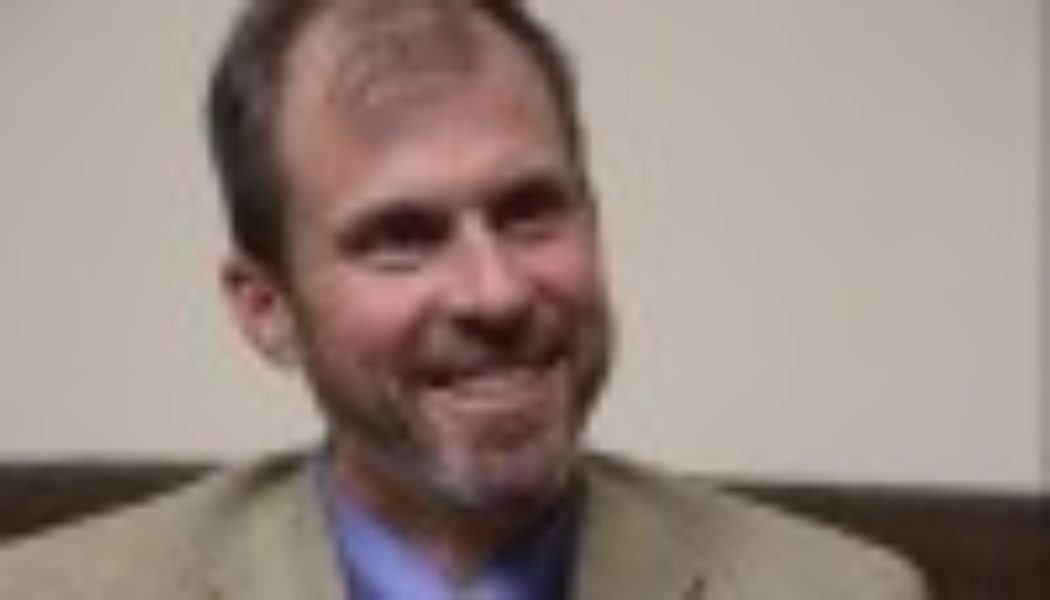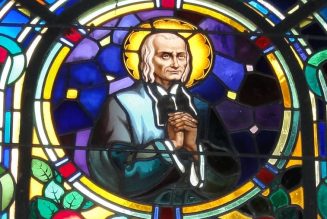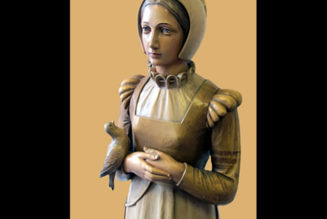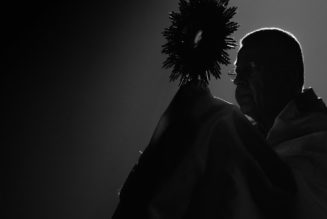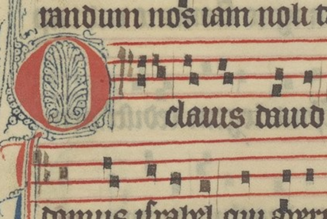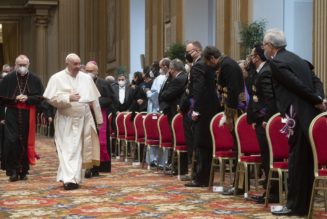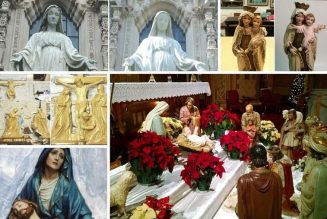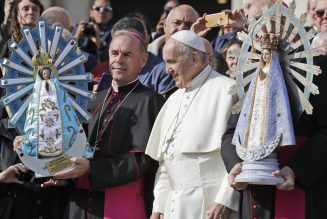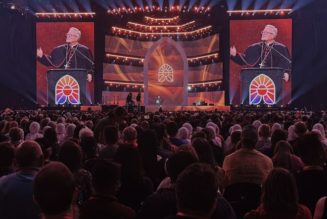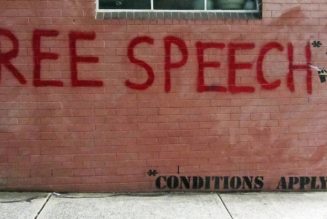How we bury our dead is a crucial part of life. We have gotten away from the wise practices of our ancestors. If how they did burial was largely out of necessity, we might still discover just how important those practices are—how much we really need them today. And we can choose them, at least some of them, again.
The day we buried my father some years ago was one of the most important days of my life. Here is a brief retelling of it and a few reflections that it occasioned. I hope many others might receive, or give, such a gift.
It was all about the earth. Opening it, placing something it, and closing it. Like planting a seed. We started with the assumption that the more we did with our own hands the better. We knew that my father had enough hearty pall-bearers that we could actually carry his casket. With an open casket wake, we knew we could at least put a hand on his breast or hands, and feel him dead.
But we wondered whether we could involve our whole selves in burying him: digging a hole, lowering a wooden casket into the bare earth, and asking our fellow mourners to return the earth to make Dad’s mound. Digging the hole by hand turned out to be unrealistic; or in any case it is unrealistic in our part of the Shenandoah Valley where close under the topsoil lie ridges of shale. Yet in the end we were overjoyed with how our own bodies enabled and enacted a wholistic mourning process.
Opening the Earth
I vividly remember going to my first wake as a young child. My father and I flew to New York City where his uncle had died suddenly of a heart attack while shoveling snow. Uncle Alfred was laid out in a grey suit engulfed in the scent of roses. It was the first time I had seen a dead human body, and the smell of roses still brings back the image. But I have no recollection of the burial. None.
We call a phase of today’s funeral process “the burial,” but the reality is that for the most part it is experienced as graveside prayers, with the hole carefully masked with astroturf, and the tools of burial parked at an awkward distance, neither quite nearby, nor utterly hidden. In my experience of these burials, nobody is actually buried.
Of the many wakes, funerals and burials I have attended, one that most stands out in my mind is that of my paternal grandmother. I have an image of her coffin suspended over a hole in the ground. I know it is a hole in the ground, though I did not see any soil, or digging or backfilling. And I trust that my grandmother’s body was lowered into that hole, though evidence I have none. That image of the suspended coffin is my last of the burial, followed by an image of the gravesite as visited months or years later.
Through the years I have seen a few coffins lowered into the ground, eased by crank and ratchets operated by professionals. I had never had the privilege of witnessing the digging that opens the earth, nor the backfilling that closes it.
A body deserves to be buried. There is an apparent if somewhat disturbing proximity between human body and earth, as evidenced in the body’s relatively quick ‘return’ to it, fortifying it as a kind of organic soil amendment. Having buried a body—whole or cremated—in earth or sea, we feel we have somehow done what needed to be done for the body. An oft overlooked issue is: have we done what needed to be done for us?
It seems fitting to ask: what kind of burial is good for those left behind? After all, though much of what we do after the death of a person is done for the sake of and in memory of the deceased, the needs of those left behind must also be considered. Prominent among these is surely the need for help in coming to terms with the truth of what has happened. We humans are prone to live in denial, especially of truths that make us uncomfortable. The death of a loved one, with all that it implies, is often just such a truth that we do not want to face. Often even if we want to, we find that we just can’t get our minds, or arms, around it.
Our loved one’s body is in fact going back to the elements from which it was formed. Any realistic facing of death must reckon with this fact. But if current post-mortem practices are any indication, we are not taking a realistic view of death. We are bent on not seeing, and even more not touching the element that most directly speaks of death.
So earth is covered with astroturf, and thus often neither seen nor touched. Let alone moved. The natural tendency of the earth to collapse into the coffin is often stayed by a concrete vault into which the coffin is settled. And beyond the occasional handfuls of dirt sent into the vault at the burial, we are not invited to close the earth over our loved one. But perhaps closure is important to closure.
The discomfort we spare ourselves now we reap later in unresolved sorrow. The Greek word catharsis refers to the release of an emotion that needs to be released. Loved ones of a deceased person stand in need of the cleansing experience of catharsis, and this especially through the fitting expression of sorrow. Though common wisdom speaks of the necessity of mourning, for some reason this wisdom does not seem to affect most of our post-mortem practices.
The common emphasis on ‘celebrating the life’ of the deceased can unwittingly both invalidate the need and remove the occasions for mourning. We are coached and coaxed to look on the bright side, and then when it is all over we find ourselves ill-prepared to face life without the deceased. We know we need to mourn, but we deprive ourselves of many of the best contexts for mourning. Such as an open-holed, dirt-moving burial.
Some years after my grandmother’s burial I found myself wondering: why did we leave Grandmother hovering over the ground? I could not shake the feeling that we had failed to bring to completion what we had begun. Something was missing, and for years I wondered if and how the next burial could be different.
It was perhaps the echo of this question combined with a yearning to comprehend, to get our hands around our father’s death, that moved us siblings to do something different with Dad. Perhaps really to face the separation of body and soul, we needed not to separate body from soul in our mourning. Following our hearts, we were surprised by burial, and given the gift to grasp death in a new way.
The Shenandoah Valley is blessed with people who are still enough connected to the earth that help was at hand for those wanting to bury a loved one in his own soil and by as much of their own labors as possible. Our inability to dig through shale by hand could have been very discouraging. But it turned out to be a blessing in disguise, for it brought into the picture our old friend Bill Mantz. Bill had been secretly wishing, though he didn’t want to put himself forward, to dig the hole for Dad with his backhoe. “John, I’m gonna think of your dad’s smile as I dig that hole.” My son Nicholas and I joined Bill at the site and were ready with shovel in hand in case we were needed for anything. As the bucket scraped away the earth, and then shale, I had occasion to begin to reckon with burial. How deep do we need to go? Just what dimensions does it need to be for Dad’s casket? Through sights, sounds, touches, and movements I was coming face to face with the reality of the last goodbye.
Closing Up and Closure
After the funeral Mass we arrived with the hearse at the cemetery. We had made clear to the funeral director at Maddox Funeral Home that we wanted to lower Dad into the ground ourselves. We were grateful that they did not think this odd, or at least were too discrete to let on. In fact, they indicated this was a very doable task, and were calm, effective coaches.
Mourners arrived to find a standard forest-green tent erected over our hole. Nearby were piles of raw dirt. Bill had set aside the topsoil to be put back last, of course on top. Mostly we had tan hard dirt that easily broke into a powder, and chunks of grey shale.
Children were fascinated. All wanted to peer in, toeing right up to the edge. Some were shooed away or pulled back by their parents, but one stood out: a girl of perhaps five who for a long period stood nudging her Sunday shoes up to the edge of the hole, in turns staring down and looking up again.
Having carried the casket from hearse to grave side, we knew the moment had come. The casket was solid chestnut, handmade from reclaimed barn lumber by our friend Mike Schmiedicke. Strong straps looped through the handles on one side, then over the top and through the handles on the other side, gave a sturdy if demanding way for the casket to be lifted. The pall bearers gave a heave and carefully moved to straddle the gaping hole. As a practical note, if you ever are lowering a casket by straps, do not wrap the strap around your wrist. At least two of us made this mistake. It is important to let the strap slip free if something goes wrong. We also lifted it too high, as if there were an invisible rim to clear, instead of just a crisp edge in the grass.
As we hefted the casket, the tension in the crowd was palpable, and my mother gasped “Dear God.” Through my strain I whispered in her direction, “We’ll make it Mom. We’ve got Dad just fine.” A brother, three sons, son-in-law, God-son, and two grandsons eased Dad’s body into the ground. And so the final committal was underway.
The prayers were brief. I stepped up to address the hundreds gathered and invite them to join us in backfilling. After the widow and the family, the guests were welcome to come forward and shovel earth in the hole. My brother handed a shovel-full to my mother. Supported by my sister, she dropped the first bit of dirt that would seal the body of her husband of fifty-seven years in the ground. The hollow thud was bracing.
It is very difficult to capture what happened over the course of the next half hour or so. Slowly, surely, the varied group of mourners came forward to do their part. It was as though they were playing a role they had played before—which, as far as we know was not the case: few had ever filled such a large hole and perhaps none had enclosed a coffin.
Everyone seemed to understand and be drawn in. The atmosphere was a unique blend of sorrow, communion, and hope. One young mother, nursling in arm, didn’t wait for a shovel, and grabbing a handful of earth tossed in her contribution. Children were as engaged in the filling as they had been in marveling at the hole. One young man shared with me as he shoveled that he remembered working for my father clearing ground many years ago. He said it was good to move earth with him one more time.
The mourners having done their part, the hole was less than half-filled. We would need more help to finish the job. I asked any willing young men to step forward so that by spelling each other we could get the job done quickly with three shovels and two rakes. Throwing earth into that hole with a purpose, I was soon soaked with perspiration and, gasping for air, handed my shovel to my nephew. The dry earth could not be moved easily. It divided itself into hard clods which handled like gravel, or escaped into the air as a fine dust the consistency of flour.
After a short break I took up a rake and scratched at the earth with a passion unlike any my garden has ever seen in me. As my body wearied I experienced a strange energy surge through my limbs. “We’ll get it done, Dad; we’ll get it done.” And so we did.
Occasionally I speak with my father. Blessed to have him buried very near to home, I can visit the site often. But I find that I don’t say very much to him there. There is a certain ease and comfort for me at the graveside, as though nothing more need be said.
The act of burying is an act of piety that is fitting for the dead. It is also an act of mourning that is fitting for the living. Our fellow-mourners who blessed us with their presence that overcast Saturday afternoon have expressed what a profound experience my father’s burial was. I think that we all experienced it as a gift: a gift that rends the heart, giving a healing and closure that lays it open to the consolation of new life beyond the grave. ~ ~ ~
TODAY’S NEW PODCAST ON BURIAL: FINDING A BETTER WAY TO BURY OUR DEAD Join Sofia and me in discussing further this issue that closely touches all of our lives! Check out and share our other PODCASTS too.
A version of this piece was originally posted at Front Porch Republic over a decade ago.
Here is my EULOGY for my father.
Here is a gallery of photos of the funeral and burial (in September 2013) courtesy of Spiering Photography.
Husband, father, and professor of Philosophy. LifeCraft springs from one conviction: there is an ancient wisdom about how to live the good life in our homes, with our families; and it is worth our time to hearken to it. Let’s rediscover it together. Learn more.
